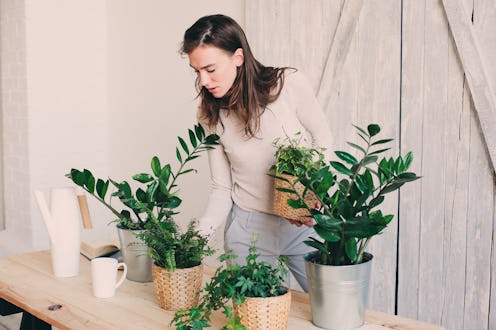Home
Got Allergies? These 5 House Plants Can Help Clear The Air
Breathe easy, plant parent.

If allergies have you sneezing with every breath and waking up to blow your nose 18 times a night, you know that pollen and air pollution can aggravate your symptoms. And no one with allergies wants more itchiness and puffiness than they've already got. Even with new-fangled, energy-efficient homes, you’re bound to bring allergens home with you. What’s a plant parent to do?
To a certain extent, “House plants can help get rid of excess carbon dioxide and improve the oxygenation in the room,” says Dr. Tania Elliott, M.D., a clinical instructor of medicine and immunology at NYU Langone. Though having greenery in a room won’t entirely cure allergies, they can be a step towards making a room feel fresher.
“House plants do have the ability to filter the air as they convert carbon dioxide into oxygen,” says Dr. Sanjeev Jain, M.D., a doctor double-board certified in immunology and internal medicine at Columbia Asthma and Allergy Clinic, “but they are not able to adequately remove substances like benzene from the air.”
In addition to stacking your plant shelf and getting a high quality air filter, make sure you’re cleaning up your pet’s fur and that dust on your dresser frequently, Dr. Elliott advises. “Outdoor allergens can track indoors and stay suspended in the air,” says Dr. Elliott. “Pet allergens can linger in the air as well.” She also recommends antihistamines like Xyzal, because sometimes your allergies need an extra kick in the proverbial pants. Whatever your typical anti-allergy regimen is, adding these seven allergy-fighting houseplants to your home can add the nose de-stuffing and mental health-boosting benefits you’ve been looking for.
1Marginata
The dracaena marginata colorama is a tri-colored dragon tree houseplant that's pretty low-maintenance and easy to grow indoors. It thrives in low light, and you'll want to let it get a bit dry before watering. With narrow, cream and yellow striped green leaves, these plants can grow up to 15 feet. The leaves turn a lighter color if they don't get enough light, but develop brown spots if exposed to too much sun.
According to the West Coast Nurseries group, marginata can help purify the air of chemicals like formaldehyde and benzene, as well as help control humidity. “Pollutants such as benzene and smoke can irritate mucous membranes and activate the immune system to respond leading to symptoms like sneezing, coughing, runny nose, congestion, and sore throat,” says Dr. Jain, though he notes that plants can’t rid a space of benzene entirely.
2Peace Lilies
This easy-to-care-for evergreen doesn't need a lot of water or light to flourish, and will tell you when it needs watering — the leaves will begin to droop. The peace lily, or spathiphyllum, is helpful for ridding the air of benzene, formaldehyde, and trichloroethylene, according to a 1989 NASA study that investigated air quality in space. However, allergy prevention won’t stop with one peace lily (alas). Make sure you’re getting a high-quality air filter to go along with your peace lily, Dr. Jain advises.
3Chinese Evergreen
Aglaonema, or Chinese evergreen is another low-maintenance houseplant that functions as a natural air purifier. It grows best in low light, and needs pretty minimal watering about every few weeks or so. Place it in a warm, somewhat humid spot in your home for best results.
4Janet Craig
Another dragon tree variety, the Janet Craig, or dracaena fragans, is a super easy house plant to grow. With bright, shiny green leaves, this floor plant can grow pretty tall — so prune it back in the spring or early summer if it starts to crowd your space. Don’t worry, because pruning will help it grow even healthier, which can make it even better at “breathing” pollutants out of your living room.
5Swedish Ivy
Swedish ivy, or Plectranthus australis, is a low-pollen houseplant and a solid choice for any newbie gardener with allergies. “Low-pollen (non-flowering) houseplants are a great option for sprucing up the home and allowing a person with environmental allergies to enjoy nature without triggering an allergic response,” Dr. Jain explains. “Allergies to most low-pollen houseplants are uncommon, so they are unlikely to cause any symptoms for someone in the home.”
Swedish ivy makes a great hanging plant and loves bright, indirect light throughout the year. It grows quickly and easily without a lot of maintenance, but be careful to keep it in rooms that don't dip below 60 degrees F — help it stay relatively warm and it’ll help you stay relatively allergy-free.
Experts:
Dr. Tania Elliott, M.D., clinical instructor of medicine and immunology, NYU Langone
Dr. Sanjeev Jain, M.D., doctor double-board certified in immunology and internal medicine, Columbia Asthma and Allergy Clinic
This article was originally published on